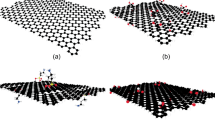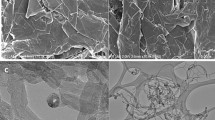Abstract
In this article, we focus to model and study a coarse-grained single layer graphene nanosheet for its surface-coverage effects using dissipative particle dynamics (DPD) simulation. In particular, the DPD simulations considering oleic acid as surfactant molecules have been accomplished to explore the adsorbed structure of graphene–oleic acid species. A weak and dynamic assembly of oleic acid molecules near graphene nanosheet is predicted. For equilibrium structure and subsequent calibration, the graphene nanosheets soaked in water have been studied by varying bond stretching and angular stiffnesses in the simulation box. The set of interaction parameters for different bead combinations were calculated using Monte Carlo method by taking a trajectory of each chemical species providing various spatial configurations. The DPD simulation forecasts a short-range molecular ordering mediated via physicochemical interaction between hydrophilic head of free oleic acid molecules and beads of planar graphene nanosheet. In general, the simulation study forecasts an insight onto the structure of graphene nanosheets and their interactions with nanoparticles coated with oleic acid under variable experimental conditions. On the basis of observations in the computer modelling, we summarized the results that how these can help in coherent design of hybrid graphene nanosheet based nanocomposites for technological applications in near future.



Similar content being viewed by others

References
C. Pavlou, M.G. Pastore Carbone, A.C. Manikas, G. Trakakis, C. Koral, G. Papari, A. Andreone, C. Galiotis, Effective EMI shielding behaviour of thin graphene/PMMA nanolaminates in the THz range. Nat. Commun. 12, 4655 (2021). https://doi.org/10.1038/s41467-021-24970-4
T. Mahmoudi, Y. Wang, Y.-B. Hahn, Graphene and its derivatives for solar cells application. Nano Energy 47, 51–65 (2018). https://doi.org/10.1016/j.nanoen.2018.02.047
S. Mura, Y. Jiang, I. Vassalini, A. Gianoncelli, I. Alessandri, G. Granozzi, L. Calvillo, N. Senes, S. Enzo, P. Innocenzi, L. Malfatti, Graphene oxide/iron oxide nanocomposites for water remediation. ACS Appl. Nano Mater. 1, 6724–6732 (2018). https://doi.org/10.1021/acsanm.8b01540
K. Tadyszak, J. Wychowaniec, J. Litowczenko, Biomedical applications of graphene-based structures. Nanomaterials 8, 944 (2018). https://doi.org/10.3390/nano8110944
O. Akhavan, M. Saadati, M. Jannesari, Graphene jet nanomotors in remote controllable self-propulsion swimmers in pure water. Nano Lett. 16, 5619–5630 (2016). https://doi.org/10.1021/acs.nanolett.6b02175
V.P. Pham, H.-S. Jang, D. Whang, J.-Y. Choi, Direct growth of graphene on rigid and flexible substrates: progress, applications, and challenges. Chem. Soc. Rev. 46, 6276–6300 (2017). https://doi.org/10.1039/C7CS00224F
S.P. Gubin, Magnetic nanoparticles (Wiley-VCH Verlag GmBH & Co KGaA, 2009)
S. Mallick, A. Shankar, B. Prasad, Bionanomaterials utility for therapeutic applications, in Bionanomaterials: fundamentals and biomedical applications. ed. by R.P. Singh, K.R.B. Singh (IOP Publishing, 2021)
R. Hudson, Y. Feng, R.S. Varma, A. Moores, Bare magnetic nanoparticles: sustainable synthesis and applications in catalytic organic transformations. Green Chem. 16, 4493–4505 (2014). https://doi.org/10.1039/C4GC00418C
N.A. Frey, S. Peng, K. Cheng, S. Sun, Magnetic nanoparticles: synthesis, functionalization, and applications in bioimaging and magnetic energy storage. Chem. Soc. Rev. 38, 2532 (2009). https://doi.org/10.1039/b815548h
M. Mishra, A.P. Singh, B.P. Singh, V.N. Singh, S.K. Dhawan, Conducting ferrofluid: a high-performance microwave shielding material. J. Mater. Chem. A. 2, 13159 (2014). https://doi.org/10.1039/C4TA01681E
A. Shankar, A.P. Safronov, E.A. Mikhnevich, I.V. Beketov, G.V. Kurlyandskaya, Ferrogels based on entrapped metallic iron nanoparticles in a polyacrylamide network: extended Derjaguin–Landau–Verwey–Overbeek consideration, interfacial interactions and magnetodeformation. Soft Matter 13, 3359–3372 (2017). https://doi.org/10.1039/C7SM00534B
E. Sadeghinezhad, M. Mehrali, A.R. Akhiani, S. Tahan Latibari, A. Dolatshahi-Pirouz, H.S.C. Metselaar, M. Mehrali, Experimental study on heat transfer augmentation of graphene based ferrofluids in presence of magnetic field. Appl. Therm. Eng. 114, 415–427 (2017). https://doi.org/10.1016/j.applthermaleng.2016.11.199
G.V. Kurlyandskaya, D.S. Portnov, I.V. Beketov, A. Larrañagad, A.P. Safronov, I. Orue, A.I. Medvedev, A.A. Chlenova, M.B. Sanchez-Ilarduya, A. Martinez-Amesti, A.V. Svalov, Nanostructured materials for magnetic biosensing. Biochim. Biophys. Acta BBA Gen. Subj. 2017, 1494–1506 (1861). https://doi.org/10.1016/j.bbagen.2016.12.003
M. Chand, A. Shankar, A. Pratap Singh, M. Chandra Mathpal, R. Prasad Pant, J. Deperyot, Mechanism of chain formation under shearing forces in magneto-rheological fluids. Mater. Today Proc. 47, 1575–1579 (2021). https://doi.org/10.1016/j.matpr.2021.03.675
A.P. Singh, M. Mishra, A. Chandra, S.K. Dhawan, Graphene oxide/ferrofluid/cement composites for electromagnetic interference shielding application. Nanotechnology 22, 465701 (2011). https://doi.org/10.1088/0957-4484/22/46/465701
O. Akhavan, A. Meidanchi, E. Ghaderi, S. Khoei, Zinc ferrite spinel-graphene in magneto-photothermal therapy of cancer. J. Mater. Chem. B. 2, 3306 (2014). https://doi.org/10.1039/c3tb21834a
H. Ren, X. Zhuang, Y. Cai, T. Rabczuk, Dual-horizon peridynamics: dual-horizon peridynamics. Int. J. Numer. Methods Eng. 108, 1451–1476 (2016). https://doi.org/10.1002/nme.5257
H. Ren, X. Zhuang, T. Rabczuk, A new peridynamic formulation with shear deformation for elastic solid. J. Micromechanics Mol. Phys. 01, 1650009 (2016). https://doi.org/10.1142/S2424913016500090
T. Rabczuk, H. Ren, X. Zhuang, A nonlocal operator method for partial differential equations with application to electromagnetic waveguide problem. Comput. Mater. Contin. 59, 31–55 (2019). https://doi.org/10.32604/cmc.2019.04567
H. Ren, X. Zhuang, T. Rabczuk, H. Zhu, Dual-support smoothed particle hydrodynamics in solid: variational principle and implicit formulation. Eng. Anal. Bound. Elem. 108, 15–29 (2019). https://doi.org/10.1016/j.enganabound.2019.05.024
P.J. Hoogerbrugge, J.M.V.A. Koelman, Simulating microscopic hydrodynamic phenomena with dissipative particle dynamics. Europhys. Lett. EPL 19, 155–160 (1992). https://doi.org/10.1209/0295-5075/19/3/001
P. Español, P. Warren, Statistical mechanics of dissipative particle dynamics. Europhys. Lett. EPL 30, 191–196 (1995). https://doi.org/10.1209/0295-5075/30/4/001
R.D. Groot, P.B. Warren, Dissipative particle dynamics: Bridging the gap between atomistic and mesoscopic simulation. J. Chem. Phys. 107, 4423–4435 (1997). https://doi.org/10.1063/1.474784
T.E. Gartner, A. Jayaraman, Modeling and simulations of polymers: a roadmap. Macromolecules 52, 755–786 (2019). https://doi.org/10.1021/acs.macromol.8b01836
R.D. Groot, K.L. Rabone, Mesoscopic simulation of cell membrane damage, morphology change and rupture by nonionic surfactants. Biophys. J. 81, 725–736 (2001). https://doi.org/10.1016/S0006-3495(01)75737-2
G. Korneva, H. Ye, Y. Gogotsi, D. Halverson, G. Friedman, J.-C. Bradley, K.G. Kornev, Carbon nanotubes loaded with magnetic particles. Nano Lett. 5, 879–884 (2005). https://doi.org/10.1021/nl0502928
T.N. Narayanan, A.P. Reena Mary, M.M. Shaijumon, L. Ci, P.M. Ajayan, M.R. Anantharaman, On the synthesis and magnetic properties of multiwall carbon nanotube–superparamagnetic iron oxide nanoparticle nanocomposites. Nanotechnology 20, 055607 (2009). https://doi.org/10.1088/0957-4484/20/5/055607
R.P. Pant, A. Shankar, K. Jain, Sonia, M. Chand, Ferrofluid-MWCNT hybrid nanocomposite in liquid state, US20150371776A1, 2015. http://www.patentsencyclopedia.com/imgfull/20150371776_01
D. Yang, X. Li, D. Meng, Y. Yang, Carbon quantum dots-modified ferrofluid for dispersive solid-phase extraction of phenolic compounds in water and milk samples. J. Mol. Liq. 261, 155–161 (2018). https://doi.org/10.1016/j.molliq.2018.04.036
Y. Chu, S. Bilal, M.R. Hajizadeh, Hybrid ferrofluid along with MWCNT for augmentation of thermal behavior of fluid during natural convection in a cavity. Math. Methods Appl. Sci. (2020). https://doi.org/10.1002/mma.6937
W. Zhang, M. Zhou, H. Zhu, Y. Tian, K. Wang, J. Wei, F. Ji, X. Li, Z. Li, P. Zhang, D. Wu, Tribological properties of oleic acid-modified graphene as lubricant oil additives. J. Phys. Appl. Phys. 44, 205303 (2011). https://doi.org/10.1088/0022-3727/44/20/205303
T. Chen, Y. Xia, Z. Jia, Z. Liu, H. Zhang, Synthesis, characterization, and tribological behavior of oleic acid capped graphene oxide. J. Nanomater 2014, 1–8 (2014). https://doi.org/10.1155/2014/654145
X. Liu, D. Ma, H. Tang, L. Tan, Q. Xie, Y. Zhang, M. Ma, S. Yao, Polyamidoamine dendrimer and oleic acid-functionalized graphene as biocompatible and efficient gene delivery vectors. ACS Appl. Mater. Interfaces. 6, 8173–8183 (2014). https://doi.org/10.1021/am500812h
S. Askari, R. Lotfi, A.M. Rashidi, H. Koolivand, M. Koolivand-Salooki, Rheological and thermophysical properties of ultra-stable kerosene-based Fe3O4/Graphene nanofluids for energy conservation. Energy Convers. Manag. 128, 134–144 (2016). https://doi.org/10.1016/j.enconman.2016.09.037
S. Seidi, N.S. Moosavi, M. Shanehsaz, M. Abdolhosseini, S.J. Sadeghi, Rapid ultrasound-assisted dispersive solid-phase extraction of nonsteroidal anti-inflammatory drugs in urine using oleic acid functionalized magnetic graphene oxide. J. Sep. Sci. 41, 4370–4378 (2018). https://doi.org/10.1002/jssc.201800663
J.S. Boruah, D. Chowdhury, Hybrid oleic acid-graphene quantum dot vesicles for drug delivery. ChemistrySelect 4, 4347–4354 (2019). https://doi.org/10.1002/slct.201803619
M. Khalilifard, S. Javadian, Magnetic superhydrophobic polyurethane sponge loaded with Fe3O4@oleic acid@graphene oxide as high performance adsorbent oil from water. Chem. Eng. J. 408, 127369 (2021). https://doi.org/10.1016/j.cej.2020.127369
A. Maiti, S. McGrother, Bead–bead interaction parameters in dissipative particle dynamics: relation to bead-size, solubility parameter, and surface tension. J. Chem. Phys. 120, 1594–1601 (2004). https://doi.org/10.1063/1.1630294
L. Verlet, Computer “experiments” on classical fluids. I. Thermodynamical properties of lennard-jones molecules. Phys. Rev. 159, 98–103 (1967). https://doi.org/10.1103/PhysRev.159.98
J. Mao, R. Guo, L.-T. Yan, Simulation and analysis of cellular internalization pathways and membrane perturbation for graphene nanosheets. Biomaterials 35, 6069–6077 (2014). https://doi.org/10.1016/j.biomaterials.2014.03.087
J. Medina, F. Avilés, A. Tapia, The bond force constants of graphene and benzene calculated by density functional theory. Mol. Phys. 113, 1297–1305 (2015). https://doi.org/10.1080/00268976.2014.986241
S.H. Min, C. Lee, J. Jang, Dissipative particle dynamics modeling of a graphene nanosheet and its self-assembly with surfactant molecules. Soft Matter 8, 8735 (2012). https://doi.org/10.1039/c2sm26029h
B. Hafskjold, C.C. Liew, W. Shinoda, Can such long time steps really be used in dissipative particle dynamics simulations? Mol. Simul. 30, 879–885 (2004). https://doi.org/10.1080/08927020410001709370
Y. Li, H. Yuan, A. von dem Bussche, M. Creighton, R.H. Hurt, A.B. Kane, H. Gao, Graphene microsheets enter cells through spontaneous membrane penetration at edge asperities and corner sites. Proc. Natl. Acad. Sci. 110, 12295–12300 (2013). https://doi.org/10.1073/pnas.1222276110
I.W. Frank, D.M. Tanenbaum, A.M. van der Zande, P.L. McEuen, Mechanical properties of suspended graphene sheets. J. Vac. Sci. Technol. B Microelectron. Nanometer Struct. 25, 2558 (2007). https://doi.org/10.1116/1.2789446
C. Lee, X. Wei, J.W. Kysar, J. Hone, Measurement of the elastic properties and intrinsic strength of monolayer graphene. Science 321, 385–388 (2008). https://doi.org/10.1126/science.1157996
F.O. Ogundare, F.M. Adekola, I.A. Oladosu, Compositions and photon mass attenuation coefficients of diesel, kerosene, palm and groundnut oils. Fuel 255, 115697 (2019). https://doi.org/10.1016/j.fuel.2019.115697
F. Alvarez, E.A. Flores, L.V. Castro, J.G. Hernández, A. López, F. Vázquez, Dissipative particle dynamics (DPD) study of crude oil−water emulsions in the presence of a functionalized co-polymer †. Energy Fuels 25, 562–567 (2011). https://doi.org/10.1021/ef1012038
M.D. Vo, B. Shiau, J.H. Harwell, D.V. Papavassiliou, Adsorption of anionic and non-ionic surfactants on carbon nanotubes in water with dissipative particle dynamics simulation. J. Chem. Phys. 144, 204701 (2016). https://doi.org/10.1063/1.4949364
W.S. Hummers, R.E. Offeman, Preparation of graphitic oxide. J. Am. Chem. Soc. 80, 1339–1339 (1958). https://doi.org/10.1021/ja01539a017
A. Shankar, M. Chand, G.A. Basheed, S. Thakur, R.P. Pant, Low temperature FMR investigations on double surfactant water based ferrofluid. J. Magn. Magn. Mater. 374, 696–702 (2015). https://doi.org/10.1016/j.jmmm.2014.09.038
A. Shankar, A.P. Safronov, E.A. Mikhnevich, I.V. Beketov, Multidomain iron nanoparticles for the preparation of polyacrylamide ferrogels. J. Magn. Magn. Mater. 431, 134–137 (2017). https://doi.org/10.1016/j.jmmm.2016.08.075
Acknowledgements
The work was supported by UGC-BSR Research Start-Up-Grant F.30-420/2018(BSR), UGC, India, and by Brazilian agencies CNPq and CAPES. AS also acknowledges the encouragement by Madhya Pradesh Council of Science and Technology (MPCST), India, and financial assistance provided in the form of MP Young Scientist Award and subsequent financial support under its FTYS scheme (sanction order no. 3063/CST/FTYS/2019).
Author information
Authors and Affiliations
Corresponding author
Ethics declarations
Conflict of interest
Authors declare no competing financial interests.
Additional information
Publisher's Note
Springer Nature remains neutral with regard to jurisdictional claims in published maps and institutional affiliations.
Supplementary Information
Below is the link to the electronic supplementary material.
Rights and permissions
About this article
Cite this article
Shankar, A., Chand, M. & Sharma, S. On the mixing of graphene and oleic acid in kerosene: a dissipative particle dynamics study. Appl. Phys. A 128, 224 (2022). https://doi.org/10.1007/s00339-022-05355-w
Received:
Accepted:
Published:
DOI: https://doi.org/10.1007/s00339-022-05355-w



